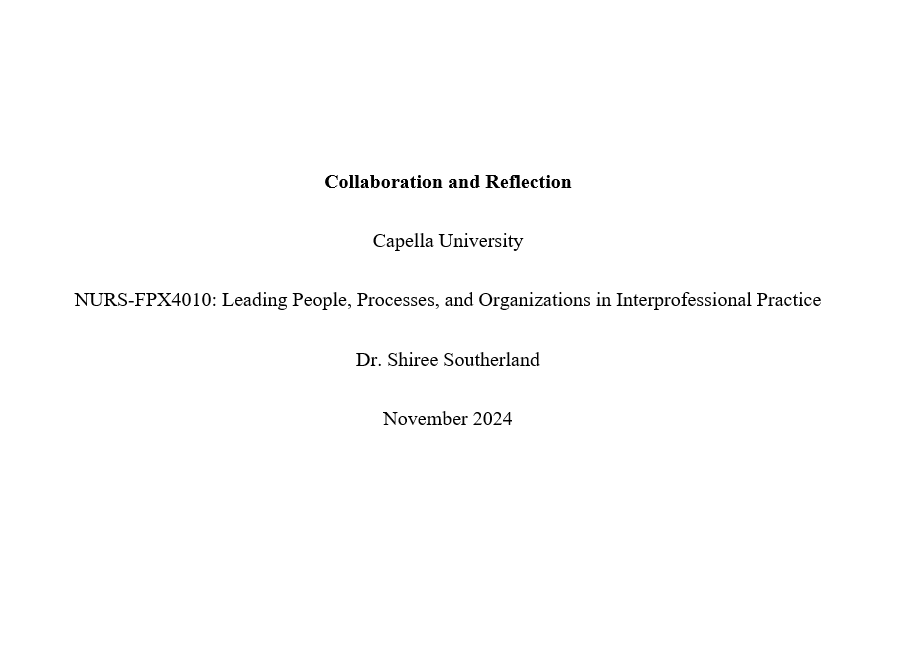NURS-FPX4010_P_Assessment 1-1 solution.docx
Collaboration and Reflection
Capella University
NURS-FPX4010: Leading People, Processes, and Organizations in Interprofessional Practice
Dr. Shiree Southerland
November 2024
Collaboration and Reflection
A recent project I participated in involved collaboration and teamwork from all healthcare practitioners who had been actively engaged in-home visits, particularly to patients with severe chronic diseases. I was part of an interdisciplinary team tasked with investigating reasons for increased patient readmissions.
The team included physicians, clinical assistants, the nurse manager, nurses, and therapists with significant frontline roles at the bedside and organizational levels. The director of clinical services expected the team to share perspectives and experiences associated with readmissions.
A key success factor was the competency demonstrated by the nurse manager in creating an open environment. In this case, it was easier for members to share insights and suggestions on barriers and enablers of reduced readmissions.
The nursing manager came up with a well-formulated strategy used by the health care providers in the field. The greatest test for communication and collaboration focused on the need for different healthcare professionals with diverse skills and experiences to share views on strategies for preventing readmissions.
The best strategy adopted by the team involved effective time management and work ethics. The aspects ensured that the team focused more on activities related to the project deliverables. One takeaway from initiating effective collaboration was the need for an open environment that allows everyone to share suggestions on the best practices for optimizing outcomes (Udod & Racine, 2017).
A second takeaway entails excellent communication to motivate everyone to pursue mutual interests. In this case, the team members willingly exchange ideas that have a significant impact on identifying risks associated with readmissions and interventions appropriate for enhancing the quality and safety of patient care. The collaboration was successful because of visible individual and collective commitment to familiarizing with issues such as errors exposing patients to readmissions.
Effective delivery calls for proper coordination among the selected team members to expedite the implementation of the desired plans. Each team member has clear roles and responsibilities to ensure equal distribution of resources and accountability (Udod & Racine, 2017).
The team leader must ensure that they are well conversant with the skills of each member to assign each appropriate member tasks based on their capabilities. In the project, the leader gave me the duty of investigating effectiveness of practices such as bandaging and various medical tools during operations. The decision meant that I had to produce accurate and complete evidence on some of the most sensitive procedures that could expose patients to readmissions.
There were sessions where team members took time to deliberate about complex issues, and the brainstorming sessions were done online, while at other times, it was conducted in person. The use of online sessions was quite effective because it helped navigate through various issues brought about by the need to enhance flexibility in responding to ideas raised throughout the project.
The use of online channels such as smartphone chats reinforced the importance of effective communication in an interdisciplinary setting. The senior members guided junior staff members like myself on the best strategies for synthesizing evidence on readmissions and other safety concerns within the clinical environment.
One problem experienced during the project was the busy nature of some members. The members worked in demanding units that limited them from being active throughout the project. The lack of external views on the issue also limited the team from developing a comprehensive view of causes and implications of readmissions on patients and the organization.
In improving future projects, the team should consider seeking input from external parties experienced in addressing safety and quality issues that expose patients to readmissions. The goal is to make everyone aware of the different scenarios involving readmissions and evidence-based interventions for maintaining a safe clinical environment.
Improving Interdisciplinary Collaboration: Lessons from Clarion Court Skilled Nursing Facility
Leadership strategies provide a comprehensive platform for implementing interdisciplinary team objectives and strategies. Clarion Court Skilled Nursing Facility can benefit from a leader who ensures a cohesive approach to solving organizational problems, especially in the health sector. Leadership reflects individuals and collective efforts within an institution to mobilize resources available to the facility to accomplish the organization’s goals (Hussain et al., 2018).
Integrating transformative change through a transformational leadership strategy is the best leadership approach. Clarion Court Skilled Nursing Facility needs a transformational leadership style that guarantees staff members loyalty, change, and satisfaction. It is relevant to this case because a transformative leader can identify the staff shortage in some units, thus putting proper guidelines and protocols in place to address the problem.
Further, transformational leadership gives staff members a different perspective on service or delivery (Hussain et al, 2018). It expands the organization’s capability to achieve its objectives by simply implementing staff motivation and incentives.
Clarion Court Skilled Nursing Facility needs a transformative leader who will ensure that all resources and staff members understand their specific duties, which they can fully deliver. Additionally, effective communication, openness, transparency, and honesty help build the desired collaboration. The values are ideal for Clarion Court Skilled Nursing Facility since it allows the various teams to yield cohesiveness and the realization of set objectives.
As I conclude, nurses, administrators, nurse managers, physicians, the IT team, and relevant affiliates should cooperate to achieve a desired outcome. The group shares ideas necessary for creating and maintaining a highly responsive clinical environment (Nielsen et al., 2020).
Additionally, the cooperation of interdisciplinary teams depends on shared problem-solving, critical thinking, and decision-making. Everyone in team anticipates problems and share accurate and complete information before they occur. The proactive commitment to maintaining a competitive clinical environment helps the organizations to maintain a superior advantage in a complex healthcare system.
References
Hussain, S. T., Lei, S., Akram, T., Haider, M. J., Hussain, S. H., Ali, M. (2018). Kurt Lewin’s change model: A critical review of the role of leadership and employee involvement in organizational change. Journal of Innovation and Knowledge, 3(3), 123–127. https://www.sciencedirect.com/science/article/pii/S2444569X16300087
Lynch, B. M., McCance, T., McCormack, B., & Brown, D. (2017). The development of the person-centred situational leadership framework: Revealing the being of person-centredness in nursing homes. Journal of Clinical Nursing, 27(1-2), 427–440. https://pubmed.ncbi.nlm.nih.gov/28677332/
Nilsen, P., Seing, I., Ericsson, C., Birken, S., & Schildmeijer, K. (2020). Characteristics of successful changes in health care organizations: An interview study with physicians, registered nurses and assistant nurses. BMC Health Services Research, 20(147), 1-8. https://bmchealthservres.biomedcentral.com/articles/10.1186/s12913-020-4999-8
Udod, S. A., & Racine, L. (2017). Empirical and pragmatic adequacy of grounded theory: Advancing nurse empowerment theory for nurses’ practice. Journal of Clinical Nursing, 26(24), 5224–5231. https://pubmed.ncbi.nlm.nih.gov/28543705/



